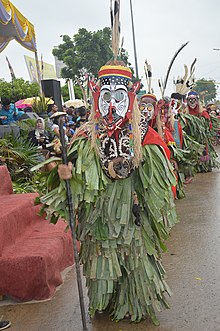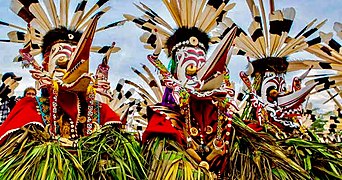Hudoq
This article needs additional citations for verification. (September 2007) |
 | |
| Native name | Tari Hudoq |
|---|---|
| Origin | Indonesia (East Kalimantan)[1] |
| Hudoq |
|---|
|
| Burma |
| Cambodia |
| Indonesia |
|
| Laos |
| Malaysia |
| Philippines |
| Thailand |
|
| Vietnam |
Hudoq is a masked dance performed during the Erau harvest thanksgiving festival by many of the sub-groups of the Dayak ethnic group in East Kalimantan province, Indonesia.[1] The Hudoq culture and performance are indigenous to the Dayak population of East Kalimantan province, and they are said to have originated from Mahakam Ulu Regency.[2]
Mythology
[edit]
According to the traditional beliefs of the Bahau, Busang, Modang, Ao’heng, and Penihing people, hudoqs are thirteen crop-destroying pests, including rats, boars, leopards, and crows. In the festival, the Hudoqs are symbolized by dancers who wear masks representing pests and jackets made of pinang (areca palm) or banana tree bark. The entire body is covered with frayed pinang palm leaves. The dance is finished when two human hudoqs come out and chase the pest hudoqs. The duration of the dance is 1–5 hours.
It is arranged from village to village after people dibble the land to grow dry-field rice paddies in September to October every year. They pray so that their fields will grow abundantly.[3]
Gallery
[edit]See also
[edit]References
[edit]- ^ a b Bhwana, Petir Garda (2019-10-27). "Government to Patent Hudoq Cross Border Traditional Dance". Tempo. Retrieved 2020-10-09.
- ^ antaranews.com (26 October 2019). "Government to patent Hudoq Cross Border traditional dance". Antara News. Retrieved 2020-10-09.
- ^ Maunati, Yekti (2003). Identitas Dayak. Yogyakarta: Lkis Pelangi Aksara. ISBN 9789799492982.
Further reading
[edit]- Festival Hudoq di Hulu Sungai Mahakam. Potensi Wisata yang Tidak Tergarap. KOMPAS, Saturday, December 8, 2001. Retrieved on August 28, 2007.













